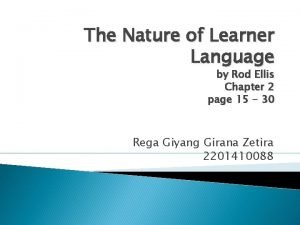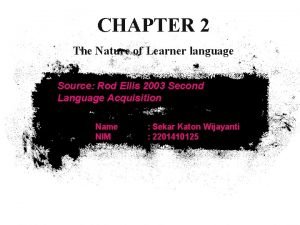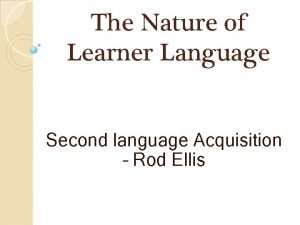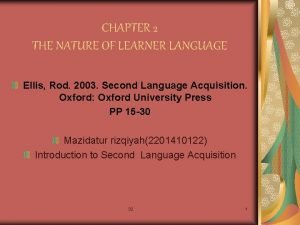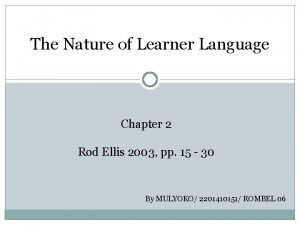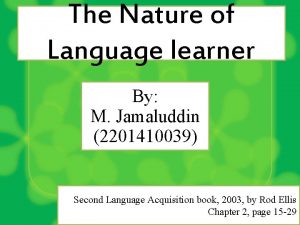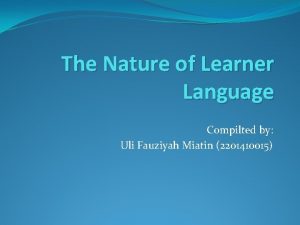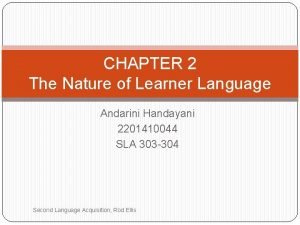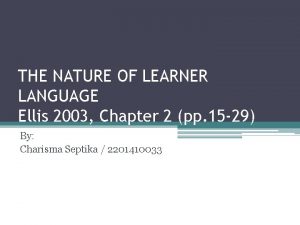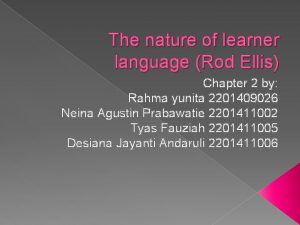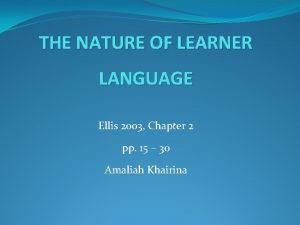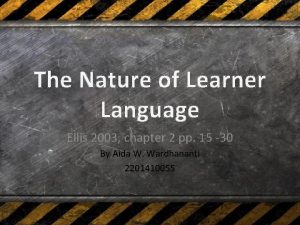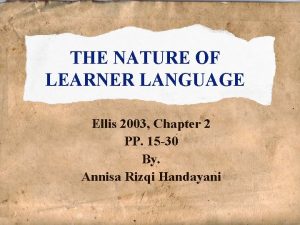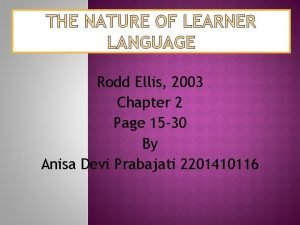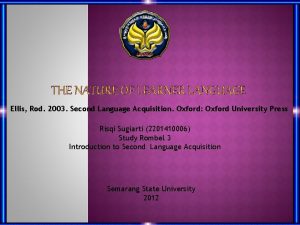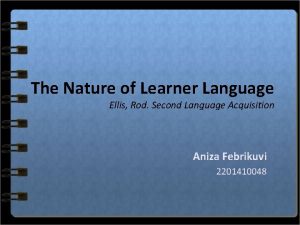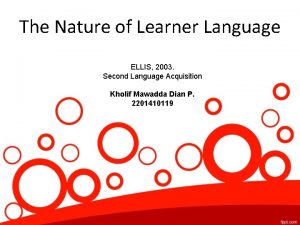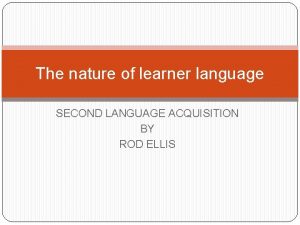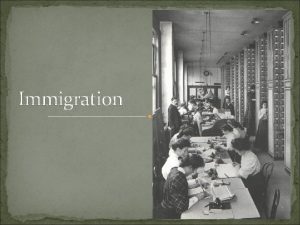CHAPTER 2 THE NATURE OF LEARNER LANGUAGE Ellis

















- Slides: 17

CHAPTER 2 THE NATURE OF LEARNER LANGUAGE Ellis, Rod. 2003. Second Language Acquisition. Oxford: Oxford University Press PP 15 -30 Mazidatur rizqiyah(2201410122) Introduction to Second Language Acquisition 32 1

The main way of investigating L 2 acquiaition is by collecting and describing sample of learner The description may focus on the kinds of errors learners make and how these errors change over time, or it my identify developmental patterns 32 2

ERRORS AND ERROR ANALYSIS There are three good reasons for focusing on errors: q. They are conpicuous q It’s useful for teacher to know what errors learners make q Making errors may actually help learners to learn when they self correct the errors they make. 32 3

How to analyze errors Identfying errors Describeing errors Explaining errors Error evaluation 32 4

Identifying Errors Telling the story orally and writing it out Comparing the two sentences Reconstruct the correct sentences Distinguish errors and mistake 32 5

Describing errors Classifying errors into grammatical catagories Trying to identify general ways in which the learners’ utterence differ from the reconstructed target language-utterence. 32 6

How to distinguish errors and mistake to check the consistency of learner’s performance. to ask learners to try to correct their own deviant utterences 32 7

Explaining errors q Some errors are common only to leaners who share the same mother tongue or whose mother tongue manifest the same linguistic property. q Example Speaker of Bantu Languages in Southern Africa frequently use the preposition ‘at’ to refer to direction as well as location. “we went at Johannesburg last weekend. ” (Bantu languages employ a single preposition ‘at’) 32 8

Error evaluation v Global Errors Violate overall structure of a sentence and for this reason may make it difficult to process. e. g The policeman was in this corner whistle. . . v Local Errors affect only a single constituent in the sentence. 32 9

DEVELOPMENTAL PATTERNS L 2 Learners make are universal and also explore the univerality of L 2 acquisition by examining the developmental pattern learners follow 32 10

How to explore the universal of L 2 acquisition The early stages of L 2 acquisition: finding out how a language is learned as natural by investigating The order of acquisition: to investigate the order of acquisition, researchers a numberal of grammatical structures study Sequence of acquisition: moving the through a series of stages en route to acquiring the native speaker rule. Some implication: Learners language changemos over time is the most important finding of SLA. 32 11

The early stages of L 2 acquisition How a language is learned: v A silent period They learn a lot about language just through listening to or reading it. v Acquisition Order Leaners begin to learn the grammar of the L 2. v The sequence of acquisition Leaners learn particular grammatical structure, such as past tense. 32 12

The order of acquisition How to investigate the order of Acquisition; v Choose a number of grammatical structures to study. v Collect samples of learner language. v Identify how accurately each feature is used by different leaners. 32 13

Sequence of acquisition v Transitional construction Stage Description example 1 Leaners fail to mark the verb for past time ‘eat’ 2 Leaners begin to produce iregular past tense forms ‘ate’ 3 Learners overgeneralize the regular past tense form ‘eated’ 4 Sometimes learnes produce hybrid forms ‘ated’ 5 Learners produce correct irregular past tense forms ‘ate’ v. U-shaped course of development v Restructuring 32 14

Some Implication v Some linguistic features (particularly grammatical) are inherently easier to learn than others. v Example of implication for both SLA theory and for language teaching. learners master plural –s before third person –s 32 15

VARIABILITY IN LANGUAGE LEARNING 32 16

THANK YOU 32 17
 Eager and lazy learning
Eager and lazy learning The nature of learner language
The nature of learner language The nature of learner language
The nature of learner language What is the nature of learner
What is the nature of learner The nature of learner language
The nature of learner language The nature of learner language
The nature of learner language The+nature+of+language+learner
The+nature+of+language+learner The nature of learner language
The nature of learner language The nature of learner language
The nature of learner language Nature and nature's law lay hid in night
Nature and nature's law lay hid in night Determinace lidské psychiky
Determinace lidské psychiky Hát kết hợp bộ gõ cơ thể
Hát kết hợp bộ gõ cơ thể Bổ thể
Bổ thể Tỉ lệ cơ thể trẻ em
Tỉ lệ cơ thể trẻ em Gấu đi như thế nào
Gấu đi như thế nào Tư thế worms-breton
Tư thế worms-breton Hát lên người ơi alleluia
Hát lên người ơi alleluia

